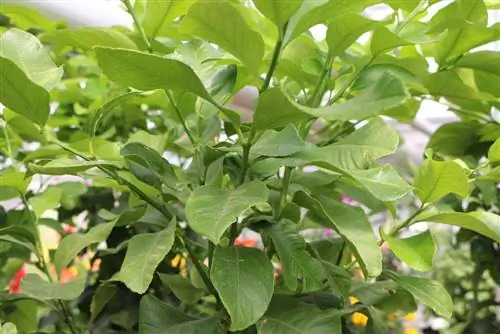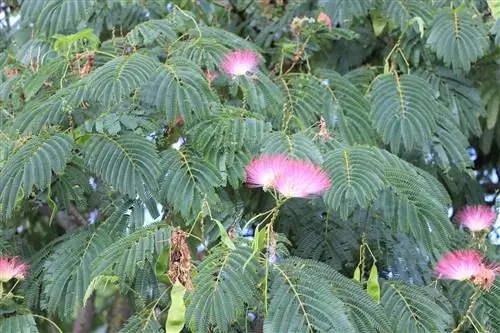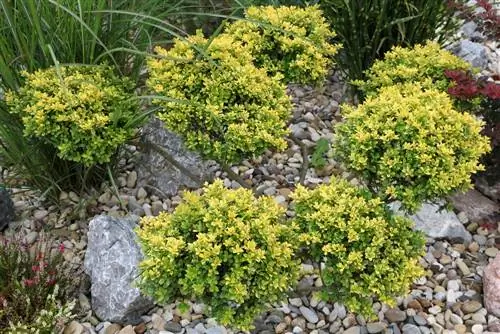- Author admin [email protected].
- Public 2023-12-17 03:39.
- Last modified 2025-06-01 06:48.
The hawthorn tree is not demanding and is a wonderful plant for beginners because it doesn't require much care, but there are still a few points that need to be taken into account when cultivating it. The choice of location is particularly important because the hawthorn tree can reach surprising sizes. But other factors are also crucial. But what is important and what needs to be taken into account?
Location
Whether next to a road or in the garden - the main thing is sunny. The hawthorn tree does not need any protection from wind and weather, but should be placed in full sun or, at most, partial shade. If the location is too dark, this is noticeable in weak growth and usually also in a reduction in flowering power. Otherwise, the hawthorn tree is resilient and can even tolerate urban climates without any problems.
Another important factor when choosing a location is the space required by the hawthorn tree. It can reach heights of between four and ten meters and therefore has a corresponding size. It is possible to keep it small permanently through regular cuttings, but it increases the maintenance effort. Because if the hawthorn is kept small, compensatory care is required. It is therefore easier and more sensible in the long term to choose a suitable location directly. Above all, this should provide upward space and also be at least three to four meters away from buildings and other tall plants.
The proximity to paths and driveways, however, is not a problem. Since the hawthorn tree is a deep-rooted tree, there is no need to expect damage from spreading roots.
Substrate
A high nutrient content of the substrate is particularly important for hawthorn. Compost, pre-fertilized soil or rose fertilizer are recommended for this. In addition, the soil for the hawthorn tree should be permeable but not too light. The following are well suited:
- Garden soil enriched with clay or loam
- pot soil
- Loamy topsoil
- Rose Soil
Mixtures of these components can also be used. Anyone who has just built can usually use the excavation directly - as it often has a high clay content and would normally be disposed of.
Plants
The hawthorn can be planted as a tree or shrub all year round. However, the ideal times are spring and autumn. The following steps are important when planting:
- The planting hole should be three times as deep and wide as the root ball.
- Fill the planting hole with the substrate mixture described above to such an extent that the hawthorn can finally be inserted into the surrounding soil line.
- After inserting the hawthorn, the planting hole is filled all around with soil and the substrate is pressed down.
- Persistent watering ensures that the roots can spread deeper more quickly.
Tip:
If compost has not been added to the substrate or pre-fertilized soil has been used, an additional fertilizer should be used when planting. However, it should be used sparingly in autumn and winter.
Pouring
The only thing that is really necessary is watering the hawthorn:
- at the bucket culture
- during prolonged dry periods
- when fertilizing for better distribution of nutrients and to prevent chemical burns on the roots
- after planting, until growth
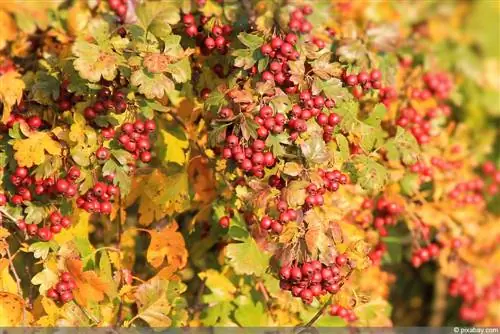
However, the hawthorn tree thrives particularly quickly and well if the substrate is always kept slightly moist. However, it cannot tolerate waterlogging.
It is also recommended to use soft water for watering. Low in calcium and therefore soft are, among other things:
- stale tap water whose sediment is not used
- filtered water
- untreated pond water
- Rainwater
Fertilize
As mentioned, additional nutrients should be added to the substrate when planting the hawthorn. But the following are also suitable:
- Rose fertilizer
- Compost
- Leaves
- Long-term fertilizer for shrubs
Depending on the fertilizer chosen, fertilization is carried out once or twice a year. A sparing dose in spring and summer is ideal. It is important to water the plant thoroughly. In this way, the nutrients are distributed more evenly in the soil and excessive concentrations are avoided. This prevents harmful reactions between highly concentrated fertilizers and the roots - so-called chemical burns.
Blend
To ensure that the hawthorn grows densely and strongly and also reduces the risk of pest infestation, annual cutting is recommended. This should be done in summer immediately after flowering, otherwise the buds will be removed for the next flowering. The following are blended:
- crossing and inwardly growing shoots
- damaged plant parts
- Water shoots that are weak and thin
- Branches that are too close together
It should be noted that the buds or flowers only appear on two-year-old shoots of the hawthorn tree. Therefore, older branches and main shoots should not be trimmed. It is also important to use clean cutting tools so as not to risk infections. In addition to this annual maintenance cut, more radical shortening may also be necessary.
Radical waste
Whether the tree or shrub has become too large or has been attacked by pests - in some cases it is necessary to prune the hawthorn more radically. An otherwise he althy and strong hawthorn tree can tolerate such occasional radical cutting, but if the cutting is carried out annually to limit the size, the care effort increases.
In the event of a disease or pest infestation, all affected plant parts should be removed and an appropriate plant protection product used. Disinfecting the cutting tools before and after use is crucial in order not to transmit germs or parasites.
Culture in a bucket
As long as the hawthorn is still small, it can also be cultivated in a bucket. The following factors are important for this type of culture:
- Sufficiently large and high pot so that the deep-rooted plant can spread accordingly
- frequent watering
- annual fertilization
- Repotting as needed
The care required here is slightly higher than with hawthorn in the field.
Repotting
When growing in a bucket, repotting is also necessary as a care measure. This is done when the plant's growth slows or roots are visible at the bottom of the pot.
The procedure is as follows:
- Free the root ball of old substrate and carefully rinse off any remaining soil.
- Prepare fresh substrate and, if it has not already been pre-fertilized, add well-rotted compost or rose fertilizer.
- Choose a planter that is one or two sizes larger than the previous pot.
- After inserting, immerse the vessel or pour water.
Propagation
The hawthorn can be propagated in three ways:
- about seeds
- through root runners
- by grafting on hawthorn
Propagation via seeds
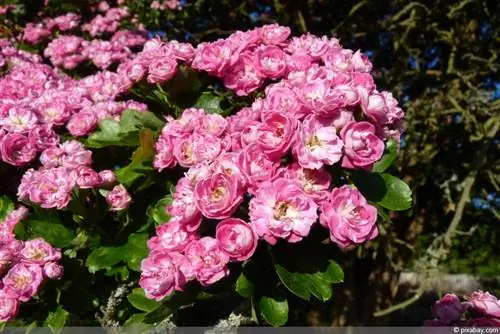
After the flowering period, fruits containing the seeds form on the hawthorn. If the fruits are dried and opened, the seeds can be planted in potting soil. However, germination takes a long time, so patience is required.
If you still decide to do so, you should consider the following points:
- Keep substrate moist at all times
- Place the cultivation container in a bright, warm place
- If possible, cover the container with foil or a pane of glass and ventilate daily
If germination occurs after several weeks to months, the young plants should be separated from a height of around ten centimeters and placed in the nutrient-rich substrate described above. In the beginning, it also makes sense to continue to cultivate the plants indoors in a bright, warm location. They should only be placed outdoors in warm weather when they reach a height of 20 to 30 centimeters.
Propagation via root runners
The easiest and fastest way to propagate hawthorn is to use root runners. If young plants are around 15 to 20 centimeters high, they are dug up generously and planted separately.
With this variant of propagation there are no waiting times and no skill or comprehensive knowledge is necessary.
Propagation via grafting
The hawthorn can also be propagated by grafting a cutting onto a hawthorn trunk - i.e. grafting it. However, this requires the appropriate knowledge and sensitivity. Even then, there is no guarantee that the hawthorn tree will propagate successfully.
The variant is therefore not suitable for beginners in plant care.
Wintering
Hawthorn trees planted outdoors are extremely frost-hardy and therefore only require additional winter protection in individual cases. This applies, for example, to planting in autumn. Since the hawthorn does not have enough time to grow completely before the onset of frost, the roots should be protected. This also applies to very young plants. It is advisable to pile up insulating materials on the tree disc. Suitable for this include:
- Leaves
- Straw
- Compost
- brushwood
If compost is used, fertilization can be skipped in the spring. As increasing temperatures increase the release of nutrients from it.
If the hawthorn is cultivated in a bucket, it should overwinter indoors. Here it should be kept bright, cool but frost-free at temperatures of up to 18 °C. If the plant is overwintered indoors, it should also be watered from time to time. It is important to prevent the substrate from drying out completely.
Typical diseases, pests and care errors
The hawthorn itself is a resistant and robust plant. Unfortunately, it is still not safe from diseases and pests. An infestation or infection is possible with:
- Aphids
- Web moths and their caterpillars
- Firebrand
Aphids like to feed on the sap of hawthorn leaves, but they are also easy to control. Natural predators such as ladybirds can be used against them. Pesticides that are gentle on beneficial insects and contain potassium soap or rapeseed oil are also suitable. In the case of a very light infestation or for pre-treatment, the leaves can also be sprayed with a jet of water.
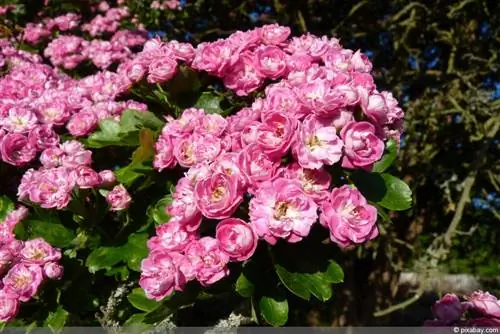
Fighting web moths and their larvae is a little more difficult. The pests spin webs that resemble spider webs. The larvae or caterpillars are visible in these. Spraying with an appropriate pesticide is difficult because the moths' nets prevent sufficient wetting. Therefore, they must first be removed. Options for this include winding the nets on a stick, burning them off in a targeted manner or radically cutting off the affected plant parts. Only then should pesticides be used.
Fire blight is particularly dangerous and must be reported. This is a bacterial infection. He can be recognized by:
- strikingly dark leaf veins
- Leaves and shoots turn dark to black, but do not fall off
- growth is noticeably reduced
If the infestation is still limited to small sections, affected plant parts are radically cut off and destroyed. In combination with this, an appropriate plant protection product must be used. In the case of an advanced infection with fire blight, the entire hawthorn must be destroyed to prevent the bacteria from spreading.
Typical care mistakes include:
- wrong or too dark location
- lack of fertilization
- Frequent watering with lime-rich water
- complete drying out or waterlogging
- an excessive annual blend to limit the size
If growth or flowering is poor, the culture conditions should be checked.
Caution: thorns
As the name suggests, the hawthorn is covered in thorns. These are very long and pointed, which makes cutting difficult and is also dangerous for pets and children. If they get too close to the plant while playing, they can easily injure themselves on the thorns. This also applies to the area immediately below and around the bush or tree, because the thorns can also fall off. If you like to go barefoot in the garden, you should avoid hawthorn.
Stitch-proof work gloves should also be worn when cutting to avoid injuries to your hands. It is also useful to wear safety glasses so that falling or flying thorns cannot get into your eyes.




